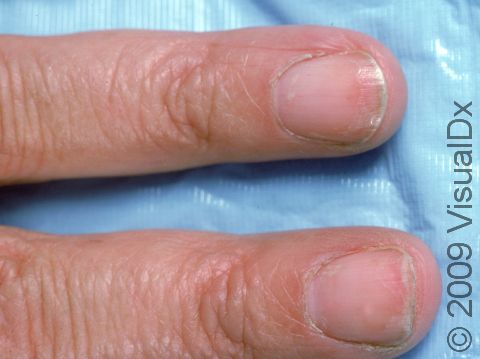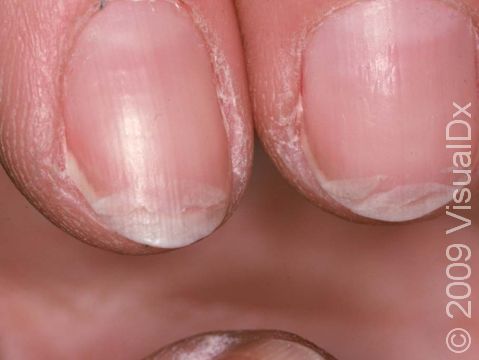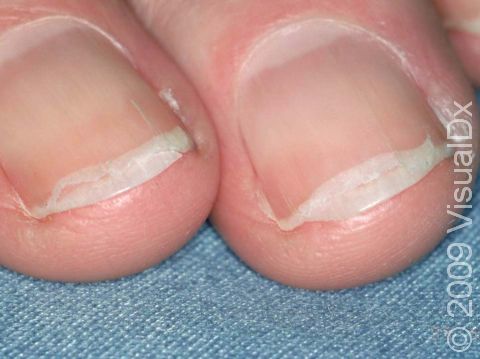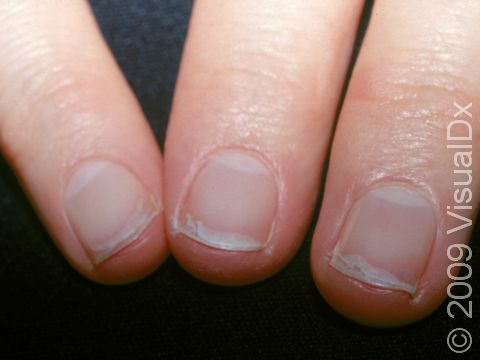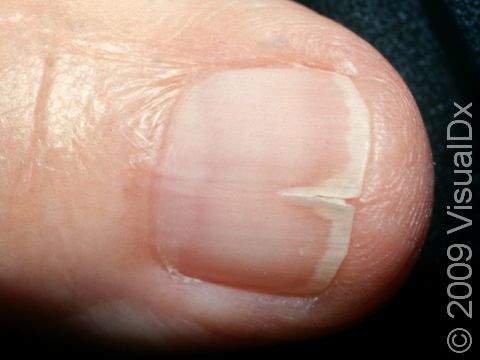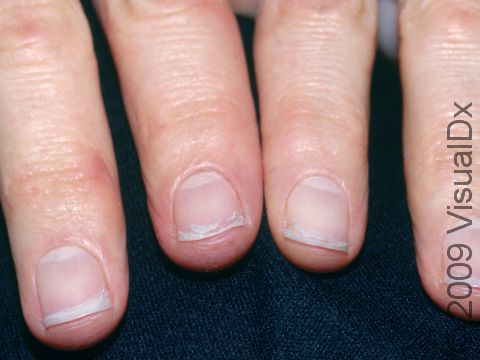Nail Splitting (Onychoschizia)
Onychoschizia, commonly known as nail splitting but also known as onychoschisis or lamellar dystrophy, is a condition that causes horizontal splits within the nail plate. Nail splitting is often seen together with onychorrhexis – long-wise (longitudinal) splitting or ridging of the nail plate – and these 2 diseases together are called “brittle nail syndrome.”
- Frequent wetting and drying of the hands is the most common cause of nail splitting, so this condition is, therefore, common among house cleaners, nurses, and hairdressers.
- Nail splitting may also be caused by nail cosmetics (hardeners, polish, polish removers/solvents), nail procedures, and occupational exposure to various chemicals (alkalis, acids, cement, solvents, thioglycolates, salt, sugar solutions).
- Injury (trauma) may also play a role in the development of brittle nails.
- Brittle nails may occur due to medical problems, including gland (endocrine system) diseases, tuberculosis, Sjögren syndrome, and malnutrition.
- People with other skin diseases, such as lichen planus and psoriasis, as well as people taking oral medications made from vitamin A, may also develop nail splitting.
Who's At Risk?
- Brittle nails affect nearly 20% of the population.
- Nail splitting is seen more frequently in women and older individuals.
- People in occupations requiring frequent wetting and drying of the hands are at increased risk for nail splitting.
Signs & Symptoms
- Nail splitting affects the fingernails and the toenails. The condition may appear as a single horizontal split between layers of the nail plate at the growing end or as multiple splits and loosening of the growing edge of the nail plate.
- Horizontal nail splitting may occur along with onychorrhexis, with longitudinal ridging or splitting as well.
- Horizontal splits at the origin of the nail plate may be seen in people with psoriasis or lichen planus or in people who use oral medications made from vitamin A.
Self-Care Guidelines
- Reduce how often you wet and dry your nails.
- Wear plastic or rubber gloves over thin cotton gloves while doing all housework, including food preparation.
- Keep the nails trimmed short to reduce worsening of nail splitting.
- Soak the nails in water daily, 15 minutes at a time, to increase the water content (hydration) of the nails.
- Apply moisturizers (emollients), such as petroleum jelly or Cetaphil®, to improve nail hydration.
- Nail-hardening agents containing formaldehyde may increase nail strength, but they should be used cautiously, as they can cause brittleness and other nail problems. Apply these hardeners only to the free edge (growing end) of the nail.
- Acrylate-containing hardeners are also effective, but they may cause an allergic reaction in the skin.
Treatments
There are no prescriptive measures to treat onychoschizia.
Visit Urgency
Nail splitting is generally considered a cosmetic problem, but see your doctor if the condition becomes bothersome.
Trusted Links
References
Bolognia, Jean L., ed. Dermatology, pp.263, 264, 1071-1073. New York: Mosby, 2003.
Freedberg, Irwin M., ed. Fitzpatrick’s Dermatology in General Medicine. 6th ed. pp.1848, 2590. New York: McGraw-Hill, 2003.
Last modified on October 10th, 2022 at 4:06 pm

Not sure what to look for?
Try our new Rash and Skin Condition Finder
